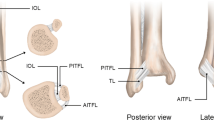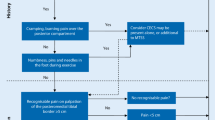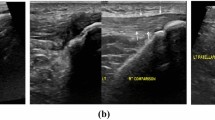Summary
Tennis elbow is due to a torque injury or sudden overstretching of tendons which insert into the epicondyles of the humerus. The predominant lesion is an enthesopathy — a pathological lesion at the insertion of tendon into bone. The most common site is at the lateral epicondyle and this is 3 times as frequent as at the medial epicondyle. Approximately 50% of tennis players can expect to get a tennis elbow at some time during their playing lifetime. In one-third of the players this will be severe enough to interfere with their tasks of daily living. The major unresolved question about the aetiology of tennis elbow is why it has its peak incidence between the ages of 40 and 50 years and why 90% of players then have no further recurrence.
Making sense of the literature on the treatment of tennis elbow is difficult because there are few tudies that have used the acceptable epidemiological techniques of the prospective randomised controlled trial or case-controlled study. Most papers are based on a collection of highly selected cases which represent the more intractable end of the tennis elbow spectrum and their reported results have been inconsistent. Tennis elbow is largely a self-limiting condition. The prime aim of treatment should be based on Hippocrates’ first tenet of medicine — first do no harm. Therapy should start with the simple and conservative before progressing to the more complex and invasive therapies. It should be acceptable to the patient, cost-effective and where invasive therapy is recommended, the potential benefits should clearly outweigh the risks. The principles of therapy for tennis elbow are to relieve pain, microbleeding and inflammation, promote healing, rehabilitate the injured arm and try to prevent recurrence. The most effective modalities of treatment are found to be cryotherapy in the acute stage then nonsteroidal anti-inflammatory drugs and heat in its various modalities including ultrasound. This is combined with rest which is best defined as the absence of painful activity. Injection of a depot preparation of cortisone is effective although patient reports are not as flattering as those of doctors. There is no advantage and in fact considerable disadvantage in using more than 2 such injections. Therapies such as acupuncture and chiropractic have not been evaluated. Nevertheless they cause no harm, may result in good and should be tried before resorting to more invasive therapy.
Rehabilitation should run parallel to treatment. This requires attention to strengthening of the muscles around the elbow joint and gradual return to full play. It also includes attention to the biomechanics of stroke production and to the type, weight and balance of racquet, tension of strings and size of grip. Invasive therapy such as Mill’s manipulation and surgery should only be used as a last resort taking care to exclude patients whose elbow pain is part of a psychiatric pain syndrome or who have been unable to follow adequate conservative therapy. The time at which the various modalities of treatment should be used depends on the occupational and to a lesser extent the leisure needs of the patient. Treatment of a patient with severe or prolonged elbow pain often requires an holistic approach involving the patient’s biological, psychological, social and occupational circumstances.
Similar content being viewed by others
References
Adelsberg S. The tennis stroke: an EMG analysis of selected muscles with rackets and increasing grip size. American Journal of Sports Medicine 14: 139–142, 1986
Bernhang AM, Dehner W, Fogarty C. Tennis elbow: a biomechanical approach. Journal of Sports Medicine 2: 235–260, 1974
Bernhang AM. The many causes of tennis elbow. New York State Journal of Medicine 79: 1363–1366, 1979
Binder AI, Hazleman PL. Lateral humeral epicondylitis — a study of natural history and the effects of conservative therapy. British Journal of Rheumatology 22: 73–76, 1983
Binder A, Parr G, Thomas PP, Hazleman B. A clinical and thermographic study of lateral epicondylitis. British Journal of Rheumatology 22: 77–81, 1983
Binder A, Hodge G, Greenwood AM, Hazleman BL, Thomas PP. Is therapeutic ultrasound effective in treating soft tissue lesions? British Medical Journal 290: 512–514, 1985
Blair SN. Risk factors and running injuries. Abstract. Medicine and Science in Sports and Exercise 17: 181, 1985
Bosworth DM. The role of the orbicular ligament in tennis elbow. Journal of Bone and Joint Surgery 37A: 527–533, 1955
Boyd HB, McLeod Jr AC. Tennis elbow. Journal of Bone and Joint Surgery 55A: 1183–1187, 1973
Brattberg G. Acupuncture therapy for tennis elbow. Pain 16: 285–288, 1983
Briggs CA, Elliott BG. Lateral epicondylitis: a review of structures associated with tennis elbow. Anatomia Clinica 7: 149–153, 1985
Brody H. Physics of the tennis racket. American Journal of Physics 47: 482–487, 1979
Brody H. Science made practical for the tennis teacher, Vol. VI, USA Professional Tennis Registry, 1985
Brody H. Vibration stoppers — do they actually work? Physics Department University of Pennsylvania, Philadelphia, 1988
Burton AK. Grip strength and forearm straps in tennis elbow. British Journal of Sports Medicine 19: 37–38, 1985
Burton AK, Edwards VA. Electromyography and tennis elbow straps. British Osteopathic Journal 14: 83–86, 1982
Calvert PT, Allum RL, Macpherson IS, Bentley G. Simple lateral release in treatment of tennis elbow. Journal of the Royal Society of Medicine 78: 912–915, 1985
Cameron HU, Proctor M, Fornaiser VL. Tennis elbow. Canadian Family Physician 29: 2177–2181, 1983
Carroll R. Tennis elbow: incidence in local league players. British Journal of Sports Medicine 15: 250–256, 1981
Carroll R. Vibrational characteristics of tennis rackets and the effect on tennis elbow sufferers. Proceedings of the Annual Conference on Human Response to Vibration, Derby, September, 1985
Carroll R. Tennis elbow and tennis rackets: case studies of club tennis players. In MacGregor & Moncur (Eds) Sports and medicine, pp. 281–288, E. & F.N. Spon, London, 1986
Carroll R, Al-Hassani STS, Leake SF. Vibrational characteristics of wood, metal and graphite tennis rackets, Centre for Physical Education, University of Manchester, 1988
Commandre FA, Valdener MB. ‘Tennis-arm’: echotomographic confirmation. Journal of Sports Medicine 23: 191–193, 1983
Coonrad RW, Hooper WR. Tennis elbow, its course, natural history, conservative and surgical management. Journal of Bone and Joint Surgery 53A: 117–118, 1973
Cyriax J. Textbook of orthopaedic medicine: diagnosis of soft tissue injuries, 5th ed. pp. 307–316, Bailliere Tindall Cassells, London, 1969
Cyriax J. Textbook of orthopaedic medicine, Vol. 2, Treatment by manipulation massage and injection, pp. 196–198, 10th ed., Bailliere, Tindall, London, 1980
Day BH, Govindasamy N, Patnaik R. Corticosteroid injections in the treatment of tennis elbow. Practitioner 220: 459–462, 1978
Devereaux MD, Hazleman BL, Thomas PP. Chronic lateral humeral epicondylitis — a double-blind controlled assessment of pulsed electromagnetic field therapy. Clinical and Experimental Rheumatology 3: 333–336, 1985
Editorial. If they knew then, what they know now. World Tennis 28: 40–43, 1980
Elliott BC, Blanksby BA, Ellis R. Vibration and rebound velocity characteristics of conventional and oversized tennis rackets. Research Quarterly for Exercise and Sport 51: 608–615, 1980
Froimson AI. Treatment of tennis elbow with forearm support band. Journal of Bone and Joint Surgery 53A: 183–184, 1971
Garden RS. Tennis elbow. Journal of Bone and Joint Surgery 43: 100–106, 1961
Gerberich SG, Priest JD. Treatment for lateral epicondylitis: variables related to recovery. British Journal of Sports Medicine 19: 224–227, 1985
Goldberg EJ, Abraham E, Siegel I. The surgical treatment of chronic lateral humeral epicondylitis by common extensor release. Clinical Orthopaedics and Related Research 233: 208–212, 1988
Goldie I. Epicondylitis lateralis. Acta Chirurgica Scandanavica (Suppl. 339): 104–109, 1964
Gregg JR, Torg E. Upper extremity injuries in adolescent tennis players. Clinics in Sport Medicine 7: 371–385, 1988
Groppel J. Tennis for advanced players and those who would like to be, Human Kinetics Publishers Inc, Champaign, IL, 1984
Groppel JL, Nirschl RP. A mechanical and electromyographical analysis of the effects of various joint counterforce braces on the tennis player. American Journal of Sports Medicine 14: 195–200, 1986
Gruchow HW, Pelletier D. An epidemiologic study of tennis elbow. American Journal of Sports Medicine 7: 234–238, 1979
Hatze H. Forces and duration of impact and grip tightness during the tennis stroke. Medicine and Science in Sports 5: 88–95, 1976
Herxheimer A (Ed.). Which NSAID? Drug and Therapeutics Bulletin 25: 81–84, 1987
Heyse-Moore GH. Resistant tennis elbow. Journal of Hand Surgery 9: 64–66, 1984
Hughes GRV, Currey HLF. Hypospray treatment of tennis elbow. Annals of Rheumatic Disease 28: 58–62, 1969
Ilfeld FW, Field SM. Treatment of tennis elbow: use of a special brace. Journal of the American Medical Association 195: 67–70, 1966
Kamien M. The ultimate accolade. Medical Journal of Australia 142: 648, 1985
Kamien M. Tennis elbow in long-time tennis players. Australian Journal of Science and Medicine in Sport 20(2): 19–27, 1988
Kaplan PE. Posterior interosseus neuropathies: natural history. Archives of Physical Medicine and Rehabilitation 65: 399–400, 1984
Kleynhans AM, Terrett AGJ. Tennis elbow. Journal of the Australian Chiropractors’ Association 14: 20–28, 1984
LaFreniere JG. Tennis elbow: evaluation treatment and prevention. Physical Therapy 59: 742–746, 1979
Leach RE, Miller JK. Lateral and medial epicondylitis of the elbow. Clinics in Sports Medicine 6: 259–272, 1987
Legwold G. Tennis elbow: joint resolution by conservative treatment and improved technique Part 1. Physician and Sports medicine 12: 168–182, 1984
Lundeberg T, Haker E, Thomas M. Effect of laser versus placebo in tennis elbow. Scandinavian Journal of Rehabilitation Medicine 19: 135–138, 1987
Magdulski G. Tennis elbow. Medical Journal of Australia 144: 391, 1986
McVay CB. Surgical anatomy, 6th ed., Vol. 2, pp. 1063–1064, W.B. Saunders, Philadelphia, 1984
Millar AP. Tennis elbow: diagnosis and treatment. Patient Management 11: 57–60, 1987
Mills GP. The treatment of ‘tennis elbow’. British Medical Journal 1: 12–13, 1928
Mills GP. Treatment of tennis elbow. British Medical Journal 2: 212–213, 1937
Morris H. The rider’s sprain. Lancet 2: 133–134, 1882
Morris H. Lawn tennis elbow. British Medical Journal 2: 557, 1883
Moss SH, Switzer HE. Radial tunnel syndrome: a spectrum of clinical presentations. Journal of Hand Surgery 8: 414–420, 1983
Murley R. Tennis elbow: conservative, surgical and manipulative therapy. Correspondence. British Medical Journal 294: 839–840, 1987
Murtagh JE. Tennis elbow, description and treatment. Australian Family Physician 7: 1307–1309, 1978
Nirschl RP. The etiology and treatment of tennis elbow. American Journal of Sports Medicine 2: 308–319, 1974
Nirschl RP, Pettrone FA. Tennis elbow. The surgical treatment of lateral epicondylitis. Journal of Bone and Joint Surgery 61 A: 832–839, 1979
Nirschl RP. Arm care, pp. 44, 55-56, Medical Sports Inc., Arlington 1981
Osgood RB. Radiohumeral bursitis, epicondylitis, epicondylalgia (tennis elbow), a personal experience. Archives of Surgery 4: 420–430, 1922
Otroszkiewicz J. Results of the treatment of epicondylitis in Bail-den foundry workers in Katowice by local injections of Depomedrol. Medical Practice 36: 337–342, 1985
Oxlund H. The influence of local injection of cortisol on the mechanical properties of tendons and ligaments and the indirect effect on skin. Acta Orthopaedica Scandinavica 51: 231–238, 1980
Peterson L, Renström P. Sports injuries: their prevention and treatment, pp. 98, 207, Methuen, Auckland, 1986
Posch JN, Goldberg VM, Larrey R. Extensor fasciotomy for tennis elbow: a long-term follow-up study. Clinical Orthopaedics and Related Research 135: 179–182, 1978
Priest JD. Tennis elbow: the syndrome and a study of average players. Minnesota Medicine 59: 367–371, 1976
Priest JD, Jones HH, Nagel DA. Elbow injuries in highly skilled tennis players. American Journal of Sports Medicine 2: 137–149, 1974
Priest JD, Braden V, Gerberich SG. The elbow and tennis, part 2: a study of players with pain. Physician and Sportsmedicine 8: 77–85, 1980
Retrum RK, Wepfer JF, Olen DW, Laney WH. Case report 355: delayed closure of the right olecranon epiphysis in a right handed tournament-class tennis player (post traumatic). Skeletal Radiology 15: 185–187, 1986
Rettig AC. Stress fracture of the ulna in an adolescent tournament tennis player. American Journal of Sports Medicine 11: 103, 1983
Roles NC, Maudsley RH. Radial tunnel syndrome: resistant tennis elbow as a nerve entrapment. Journal of Bone and Joint Surgery 54: 499–508, 1972
Rosenthal M. The efficacy of flurbiprofen versus piroxicam in the treatment of acute soft tissue rheumatism. Current Medical Research Opinion 9: 304–309, 1984
Saartok T, Ericksson E. Randomised trial of oral naproxen or local injection of betamethasone in lateral epicondylitis of the humerus. Orthopaedics 9: 191–194, 1986
Schafer RC. Chiropractic management of sports and recreational injuries, p. 390, Williams and Wilkins, Baltimore, 1982
Schneideman I. Medical acupuncture: acupuncture and the inner healer, pp 104–107, Mayfair Medical Supplies, Hong Kong, 1988
Schorn D. Tenoxicam in soft tissue rheumatism. South African Medical Journal 69: 301–303, 1986
Schultz AL. Disorders of the elbow. Digest of Chiropractic Economics 26: 14–17, 121-122, 1983
Stack JK. Acute and chronic bursitis in the region of the elbow joint. Surgical Clinics of North America 29: 155–162, 1949
Stillman FH. Preventing tennis elbow. Correspondence. New England Journal of Medicine 294: 172, 1976
Stull PA, Jokl P. Comparison of diflunisal and naproxen in the treatment of tennis elbow. Clinical Therapeutics 9(Suppl. C): 62–66, 1986
Trethowan NW. Anyone for tennis elbow? Occupational Health 38: 74–75, 1986
Uhthoff HK, Sarkar K. A re-appraisal of tennis elbow. Acta Orthopaedica Belgica 46: 74–82, 1980
Wadsworth TG. The elbow, Churchill Livingstone, Edinburgh, 1982
Wadsworth TG. Tennis elbow: conservative, surgical and manipulative treatment. British Medical Journal 294: 621–624, 1987
While ADN. A simple cure for tennis elbow. Correspondence. Medical Journal of Australia 143: 266, 1985
Wilhelm A, Wilhelm F. Thoracic outlet syndrome and its significance for surgery of the hand (on the etiology and pathogenesis of epicondylitis, tendovaginitis, median nerve compression and trophic disorders of the hand). Handchirurgie, Mikrochirurgie, Plastic Chirurgie 17: 173–187, 1985
Yerger B, Turner T. Percutaneous extensor tenotomy for chronic tennis elbow: an office procedure. Orthopaedics 8: 1261–1263, 1985
Author information
Authors and Affiliations
Rights and permissions
About this article
Cite this article
Kamien, M. A Rational Management of Tennis Elbow. Sports Med 9, 173–191 (1990). https://doi.org/10.2165/00007256-199009030-00005
Published:
Issue Date:
DOI: https://doi.org/10.2165/00007256-199009030-00005




